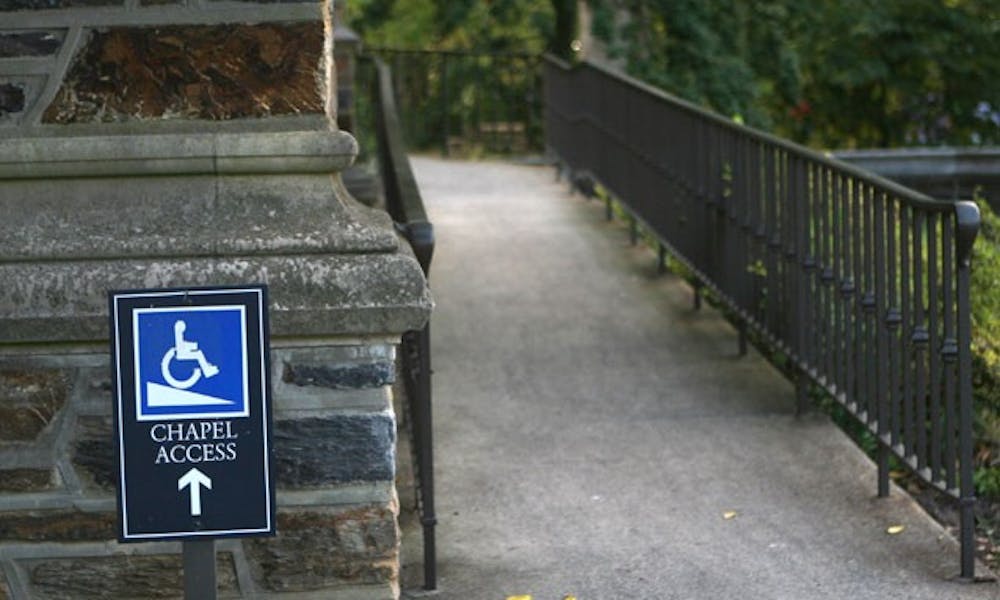For students like senior Caleb Winebrenner, getting around campus is not always too easy.
Born with cerebral palsy, which causes physical disabilities in his legs and part of the right side of his body, Winebrenner must use either a wheelchair or canes to walk, making getting around campus difficult.
Since arriving at the University, Duke has made efforts to accommodate his disability. As a freshman, Winebrenner wanted to live in Pegram Dormitory, so Disability Management System built a ramp in the back of the building for him and personalized a room to accommodate his wheelchair. This room is now used specifically for students with disabilities.
But problems remain on campus. Some of the buildings designated as accessible on campus are difficult to enter or are only accessible on the first floor, Winebrenner said, adding that the inconvenience hinders students in wheelchairs or using canes when traveling on campus.
“The West Campus Union is terrible,” Winebrenner said. “There is only one accessible entrance, and there is only one elevator, which is not open to student use. There’s no way for me to get up to things like the recording studio in a wheelchair. I can only really do anything on the first floor.”
According to the Americans with Disabilities Act of 1990, any public and commercial facilities built after July 1992 must comply with certain architectural guidelines that ensure accessibility for all people. For buildings built before that year at the University, Disability Management System has tried to add ramps or eliminate barriers when possible.
Most buildings at Duke are designated as accessible, though there are a number of notable exceptions, including Crowell Quadrangle and many of the apartments on Central Campus. Still, Duke does try to accommodate students, said Jim Baker, the disability coordinator in Student Disability Access Office.
“No matter where the student is or wants to live, we have accessible dorm space or apartments for them,” Baker said.
But for students like Winebrenner, changes in transportation and physical infrastructure are still necessary.
“The transportation system at Duke is really a hit or miss,” Winebrenner said. “The bus lifts are unreliable—some work, but others don’t.”
Last Fall, Winebrenner’s frustration over different aspects of Duke’s transportation system and the infrastructure led him and junior Lauren Blake to create a commission group called the Integrated Campus Advocacy Network, which works to foster dialogue on issues relating to disability accessibility. ICAN hopes to collaborate with administrators and DMS to point out solutions to improve accessibility on campus. This year, Winebrenner hopes to get enough signatures to make the group an official campus club, which he believes will then help the group make headway in the fight for accessibility on campus.
Blake does not have a physical disability, but she became interested in disability accessibility when she volunteered for the Special Olympics between eighth and 12th grade. She said she has several friends at Duke with physical disabilities, which has opened her eyes to the many problems students with disabilities face every day.
“Lots of students with disabilities have a hard time getting around,” Blake said. “Because of this, these students feel invisible, like they are in a special category. If students aren’t out there, administrators won’t see them and they won’t be able to help these students. ICAN seeks to have a unified group of students fighting for disability accessibility.”
Mary Thomas, the executive director of DMS, said all new construction or major alterations are being reviewed by her office. DMS conducts quarterly campus tours to identify potential issues, she added, but the office also considers student input. For example, if a person with a physical disability enrolls in a class held in an inaccessible building, DMS will move the class to a different location.
“Students can sometimes identify things that haven’t been brought to our attention, and we respond very quickly to these issues,” she said. “We are also providing on-site training for project managers to make sure we’re up to date and that we’re doing what we’re supposed to.”
Winebrenner noted that all of the disability directors and coordinators have been very helpful, and that Duke’s campus overall is much more accessible than other college campuses that he has visited, but they lack the “on the ground” perspective that people with disabilities have.
“The problem is that some people don’t understand that there is a problem, and don’t think about finding a solution to that problem,” Winebrenner said. “For example, all of the ramps are in the very back, hidden behind the buildings—what kind of message is that sending to people with disabilities?”
Blake said buildings like Perkins are great because the stairs and ramp are right next to each other. When the ramps are in the back, she added, it is like calling people with disabilities “second-class citizens.”
Winebrenner remains hopeful that ICAN, with the help of students and deans, can improve Duke’s infrastructure for the better.
“Sometimes I’ve lost my patience with the infrastructure, and several times I’ve gotten quite angry,” Winebrenner said. “But I have to do my best to be optimistic.”
Get The Chronicle straight to your inbox
Signup for our weekly newsletter. Cancel at any time.

